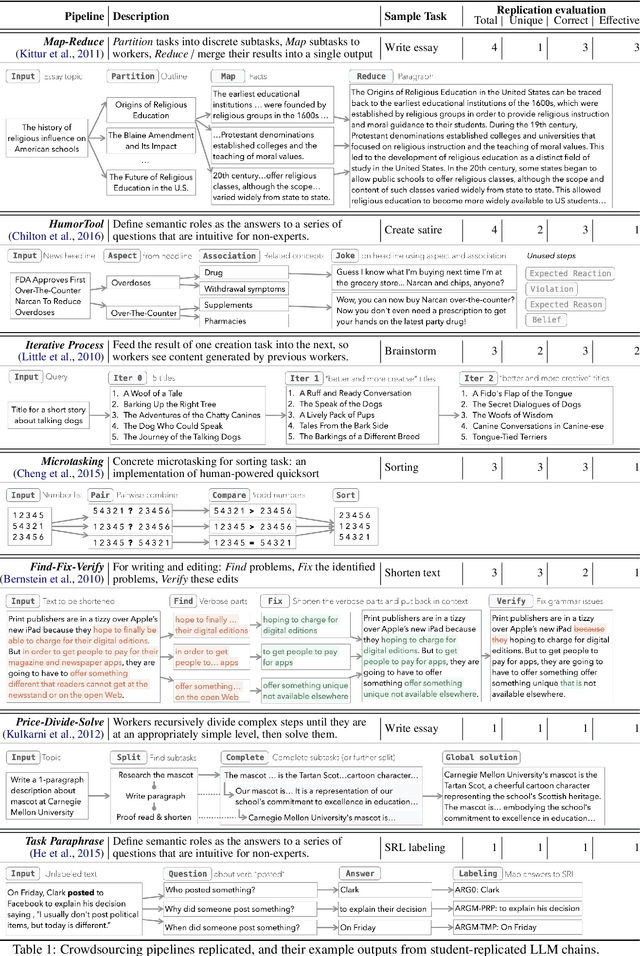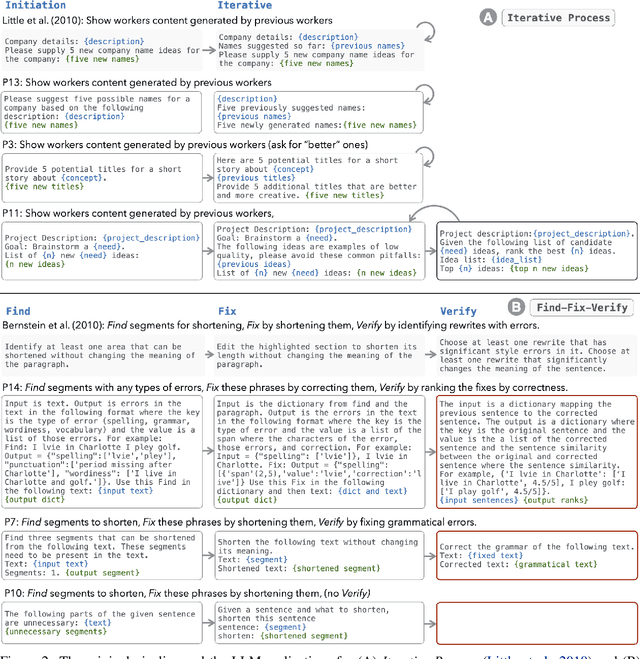Amanda Bertsch
Efficient Many-Shot In-Context Learning with Dynamic Block-Sparse Attention
Mar 11, 2025Abstract:Many-shot in-context learning has recently shown promise as an alternative to finetuning, with the major advantage that the same model can be served for multiple tasks. However, this shifts the computational burden from training-time to inference-time, making deployment of many-shot ICL challenging to justify in-practice. This cost is further increased if a custom demonstration set is retrieved for each inference example. We present Dynamic Block-Sparse Attention, a training-free framework for retrieval-based many-shot in-context learning. By combining carefully designed block-sparse attention and retrieval of cached groups of demonstrations, we achieve comparable per-example latency to finetuning while maintaining on average >95% of the best method's accuracy across strong ICL and finetuning baselines. We hope that this will further enable the deployment of many-shot ICL at scale.
Not-Just-Scaling Laws: Towards a Better Understanding of the Downstream Impact of Language Model Design Decisions
Mar 05, 2025Abstract:Improvements in language model capabilities are often attributed to increasing model size or training data, but in some cases smaller models trained on curated data or with different architectural decisions can outperform larger ones trained on more tokens. What accounts for this? To quantify the impact of these design choices, we meta-analyze 92 open-source pretrained models across a wide array of scales, including state-of-the-art open-weights models as well as less performant models and those with less conventional design decisions. We find that by incorporating features besides model size and number of training tokens, we can achieve a relative 3-28% increase in ability to predict downstream performance compared with using scale alone. Analysis of model design decisions reveal insights into data composition, such as the trade-off between language and code tasks at 15-25\% code, as well as the better performance of some architectural decisions such as choosing rotary over learned embeddings. Broadly, our framework lays a foundation for more systematic investigation of how model development choices shape final capabilities.
Better Instruction-Following Through Minimum Bayes Risk
Oct 07, 2024Abstract:General-purpose LLM judges capable of human-level evaluation provide not only a scalable and accurate way of evaluating instruction-following LLMs but also new avenues for supervising and improving their performance. One promising way of leveraging LLM judges for supervision is through Minimum Bayes Risk (MBR) decoding, which uses a reference-based evaluator to select a high-quality output from amongst a set of candidate outputs. In the first part of this work, we explore using MBR decoding as a method for improving the test-time performance of instruction-following LLMs. We find that MBR decoding with reference-based LLM judges substantially improves over greedy decoding, best-of-N decoding with reference-free judges and MBR decoding with lexical and embedding-based metrics on AlpacaEval and MT-Bench. These gains are consistent across LLMs with up to 70B parameters, demonstrating that smaller LLM judges can be used to supervise much larger LLMs. Then, seeking to retain the improvements from MBR decoding while mitigating additional test-time costs, we explore iterative self-training on MBR-decoded outputs. We find that self-training using Direct Preference Optimisation leads to significant performance gains, such that the self-trained models with greedy decoding generally match and sometimes exceed the performance of their base models with MBR decoding.
A Taxonomy for Data Contamination in Large Language Models
Jul 11, 2024Abstract:Large language models pretrained on extensive web corpora demonstrate remarkable performance across a wide range of downstream tasks. However, a growing concern is data contamination, where evaluation datasets may be contained in the pretraining corpus, inflating model performance. Decontamination, the process of detecting and removing such data, is a potential solution; yet these contaminants may originate from altered versions of the test set, evading detection during decontamination. How different types of contamination impact the performance of language models on downstream tasks is not fully understood. We present a taxonomy that categorizes the various types of contamination encountered by LLMs during the pretraining phase and identify which types pose the highest risk. We analyze the impact of contamination on two key NLP tasks -- summarization and question answering -- revealing how different types of contamination influence task performance during evaluation.
From Decoding to Meta-Generation: Inference-time Algorithms for Large Language Models
Jun 24, 2024Abstract:One of the most striking findings in modern research on large language models (LLMs) is that scaling up compute during training leads to better results. However, less attention has been given to the benefits of scaling compute during inference. This survey focuses on these inference-time approaches. We explore three areas under a unified mathematical formalism: token-level generation algorithms, meta-generation algorithms, and efficient generation. Token-level generation algorithms, often called decoding algorithms, operate by sampling a single token at a time or constructing a token-level search space and then selecting an output. These methods typically assume access to a language model's logits, next-token distributions, or probability scores. Meta-generation algorithms work on partial or full sequences, incorporating domain knowledge, enabling backtracking, and integrating external information. Efficient generation methods aim to reduce token costs and improve the speed of generation. Our survey unifies perspectives from three research communities: traditional natural language processing, modern LLMs, and machine learning systems.
In-Context Learning with Long-Context Models: An In-Depth Exploration
Apr 30, 2024Abstract:As model context lengths continue to increase, the number of demonstrations that can be provided in-context approaches the size of entire training datasets. We study the behavior of in-context learning (ICL) at this extreme scale on multiple datasets and models. We show that, for many datasets with large label spaces, performance continues to increase with hundreds or thousands of demonstrations. We contrast this with example retrieval and finetuning: example retrieval shows excellent performance at low context lengths but has diminished gains with more demonstrations; finetuning is more data hungry than ICL but can sometimes exceed long-context ICL performance with additional data. We use this ICL setting as a testbed to study several properties of both in-context learning and long-context models. We show that long-context ICL is less sensitive to random input shuffling than short-context ICL, that grouping of same-label examples can negatively impact performance, and that the performance boosts we see do not arise from cumulative gain from encoding many examples together. We conclude that although long-context ICL can be surprisingly effective, most of this gain comes from attending back to similar examples rather than task learning.
To Build Our Future, We Must Know Our Past: Contextualizing Paradigm Shifts in Natural Language Processing
Oct 11, 2023Abstract:NLP is in a period of disruptive change that is impacting our methodologies, funding sources, and public perception. In this work, we seek to understand how to shape our future by better understanding our past. We study factors that shape NLP as a field, including culture, incentives, and infrastructure by conducting long-form interviews with 26 NLP researchers of varying seniority, research area, institution, and social identity. Our interviewees identify cyclical patterns in the field, as well as new shifts without historical parallel, including changes in benchmark culture and software infrastructure. We complement this discussion with quantitative analysis of citation, authorship, and language use in the ACL Anthology over time. We conclude by discussing shared visions, concerns, and hopes for the future of NLP. We hope that this study of our field's past and present can prompt informed discussion of our community's implicit norms and more deliberate action to consciously shape the future.
It's MBR All the Way Down: Modern Generation Techniques Through the Lens of Minimum Bayes Risk
Oct 02, 2023Abstract:Minimum Bayes Risk (MBR) decoding is a method for choosing the outputs of a machine learning system based not on the output with the highest probability, but the output with the lowest risk (expected error) among multiple candidates. It is a simple but powerful method: for an additional cost at inference time, MBR provides reliable several-point improvements across metrics for a wide variety of tasks without any additional data or training. Despite this, MBR is not frequently applied in NLP works, and knowledge of the method itself is limited. We first provide an introduction to the method and the recent literature. We show that several recent methods that do not reference MBR can be written as special cases of MBR; this reformulation provides additional theoretical justification for the performance of these methods, explaining some results that were previously only empirical. We provide theoretical and empirical results about the effectiveness of various MBR variants and make concrete recommendations for the application of MBR in NLP models, including future directions in this area.
Prompt2Model: Generating Deployable Models from Natural Language Instructions
Aug 23, 2023



Abstract:Large language models (LLMs) enable system builders today to create competent NLP systems through prompting, where they only need to describe the task in natural language and provide a few examples. However, in other ways, LLMs are a step backward from traditional special-purpose NLP models; they require extensive computational resources for deployment and can be gated behind APIs. In this paper, we propose Prompt2Model, a general-purpose method that takes a natural language task description like the prompts provided to LLMs, and uses it to train a special-purpose model that is conducive to deployment. This is done through a multi-step process of retrieval of existing datasets and pretrained models, dataset generation using LLMs, and supervised fine-tuning on these retrieved and generated datasets. Over three tasks, we demonstrate that given the same few-shot prompt as input, Prompt2Model trains models that outperform the results of a strong LLM, gpt-3.5-turbo, by an average of 20% while being up to 700 times smaller. We also show that this data can be used to obtain reliable performance estimates of model performance, enabling model developers to assess model reliability before deployment. Prompt2Model is available open-source at https://github.com/neulab/prompt2model.
LLMs as Workers in Human-Computational Algorithms? Replicating Crowdsourcing Pipelines with LLMs
Jul 20, 2023


Abstract:LLMs have shown promise in replicating human-like behavior in crowdsourcing tasks that were previously thought to be exclusive to human abilities. However, current efforts focus mainly on simple atomic tasks. We explore whether LLMs can replicate more complex crowdsourcing pipelines. We find that modern LLMs can simulate some of crowdworkers' abilities in these "human computation algorithms," but the level of success is variable and influenced by requesters' understanding of LLM capabilities, the specific skills required for sub-tasks, and the optimal interaction modality for performing these sub-tasks. We reflect on human and LLMs' different sensitivities to instructions, stress the importance of enabling human-facing safeguards for LLMs, and discuss the potential of training humans and LLMs with complementary skill sets. Crucially, we show that replicating crowdsourcing pipelines offers a valuable platform to investigate (1) the relative strengths of LLMs on different tasks (by cross-comparing their performances on sub-tasks) and (2) LLMs' potential in complex tasks, where they can complete part of the tasks while leaving others to humans.
 Add to Chrome
Add to Chrome Add to Firefox
Add to Firefox Add to Edge
Add to Edge